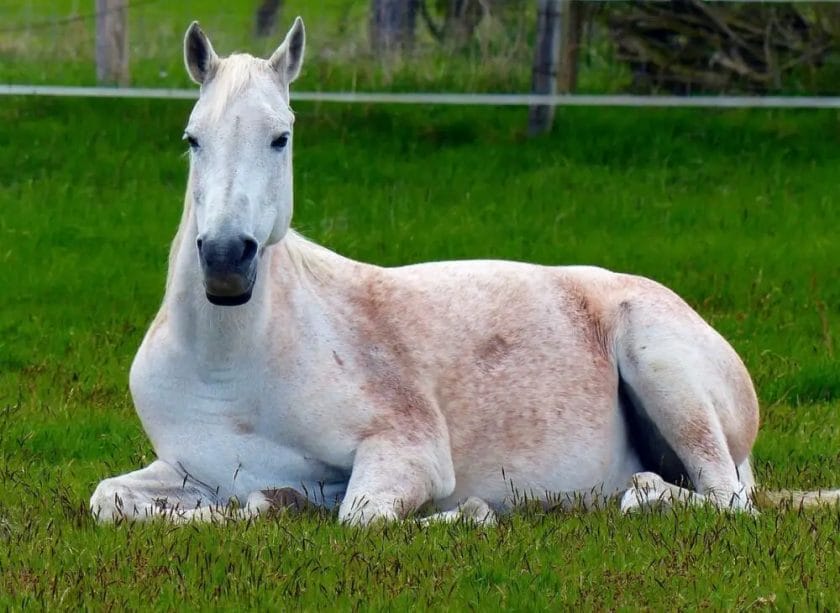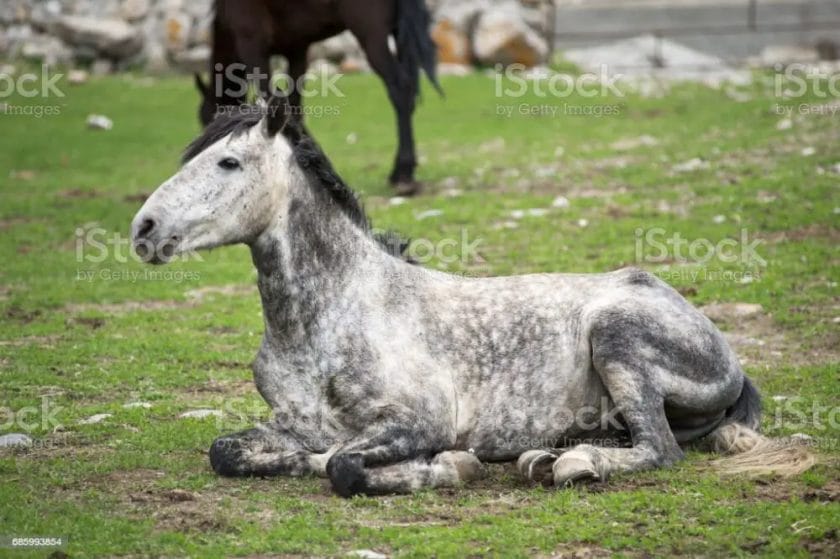Horses are not capable of sitting down in the same way humans do. Instead, they have the ability to lie down or rest in a horizontal position. This is because their anatomy and musculature are adapted for standing and running rather than sitting. Although horses can lie down to rest, they typically sleep while standing up, a behavior known as “staying”.

Do Horses Sit Down to Rest?
Have you ever wondered if horses sit down to rest? It’s a common question among horse enthusiasts and those curious about equine behavior. In this section, we will explore whether horses sit down or adopt a different resting posture.
Horses have a unique way of resting called “lying down.” Unlike humans or other animals that sit or lay down on the ground, horses have the ability to fully lie down on their side. This resting position allows them to relax their muscles and get much-needed sleep.
While horses do lie down to rest, they rarely sit down like humans or dogs do. The anatomy of a horse makes it difficult for them to sit in a traditional way. Their long, slender legs and the distribution of weight in their bodies make it impractical for them to sit on their hindquarters like humans do.
Instead, horses have evolved to lie down fully when they need to rest or sleep. This behavior is essential for their overall well-being, as it allows them to enter deep sleep cycles and fully relax their bodies. Horses require up to two to three hours of sleep per day, and lying down is a crucial part of their resting routine.
When horses lie down, they typically choose a soft, safe area where they can feel comfortable. This can be a grassy field, a sandy paddock, or a clean stall with ample bedding. They carefully lower themselves to the ground, keeping their legs tucked beneath them, and rest on one side of their body. Horses are known to switch sides periodically during their resting period to prevent soreness and distribute pressure evenly.
It’s important to note that horses can also rest while standing. They have a unique adaptation called the “stay apparatus” that allows them to lock their legs and doze off while on their feet. This mechanism enables horses to rest without fully lying down, particularly when they are in a group or have to remain alert to potential threats.
Overall, while horses do not sit down like humans, they have their own unique way of resting by lying down. This behavior allows them to get the sleep they need and recharge their bodies. Whether they choose to lie down or rest while standing, horses prioritize their well-being and find the most comfortable position to relax.

Is Sitting Down Unusual for Horses?
When we think of horses, we often imagine them standing tall and proud, running freely in the wild or galloping across open pastures. However, have you ever wondered if horses can sit down like other animals? In this section, we will explore whether sitting down is unusual for horses and shed light on their unique anatomy and behaviors.
It is important to note that horses are not designed to sit down in the same way as humans or other animals. Their anatomy and physical structure make sitting down in the traditional sense challenging and uncomfortable for them. Unlike humans, horses have long, muscular legs and a large, heavy body that is better suited for standing and moving rather than sitting.
While horses cannot sit down in the conventional manner, they do have the ability to rest and relax in a lying down position. Horses have a natural instinct to lie down for short periods of time to rest, sleep, or simply relax. This is known as “recumbency” and is a natural behavior observed in horses in both wild and domestic settings.
When horses lie down, they usually do so on their side with their legs tucked beneath them. This position allows them to distribute their body weight evenly and take pressure off their joints and muscles. It is their way of giving their legs and feet a break from bearing their weight constantly.
While it is not unusual for horses to lie down to rest, it is worth mentioning that horses are prey animals and have a natural instinct to stay alert and ready to flee from potential threats. As a result, horses tend to sleep in short increments while standing up, a behavior called “standing rest.” This allows them to quickly react and escape in case of danger.
In summary, sitting down in the traditional sense is unusual for horses due to their anatomical structure. However, horses have the ability to lie down and rest, which is an essential part of their natural behavior. So, the next time you see a horse relaxing on the ground, remember that they may not be sitting down like humans, but they are finding a comfortable way to rest and recharge.

How Do Horses Lie Down?
Have you ever wondered how horses lie down? Horses are large, powerful animals that spend a significant amount of time standing and moving. But just like any other creature, they also need to rest and sleep. In this section, we will explore the fascinating behavior of horses lying down and the mechanics behind it.
The Importance of Rest
Rest and sleep are essential for the overall well-being of horses. Just like humans, horses need to recharge their bodies and minds to stay healthy. While horses can sleep standing up, they typically prefer to lie down for a more restful sleep. Lying down allows their muscles to relax completely and promotes better blood circulation.
The Process of Lying Down
The process of a horse lying down involves a careful and intricate sequence of movements. Unlike humans who can simply sit or lie down, horses have a unique anatomical structure that requires specific steps to get down on the ground.
First, the horse will shift its weight to one of its hind legs, either the left or right. It will then lower its back end, flexing its hind legs and slowly bending its knees. This gradual descent helps to distribute the weight evenly and prevents any sudden impact on the legs or joints.
As the hind legs continue to bend, the horse will gradually lower its front end by stretching its neck forward and down. This movement helps to maintain balance as it brings the horse closer to the ground. Finally, the horse will carefully lower its chest and front legs, eventually resting its entire body on the ground.
Getting Back Up
Getting back up is a process that requires some effort and coordination from the horse. To rise from a lying position, the horse will first extend its front legs and push its chest off the ground. It will then use its powerful hind legs to push itself up, straightening its hindquarters and lifting its back end.
While it may seem like a simple task for humans, getting up from a lying position can be challenging for horses, especially if they have been resting for an extended period. It requires significant muscle strength and coordination to lift their heavy bodies off the ground.
Factors Affecting Lying Down Behavior
The behavior of lying down in horses can be influenced by various factors. Horses are prey animals and have a strong instinct to be alert and ready to flee from potential dangers. Therefore, they need to feel safe and secure before they can fully relax and lie down.
Other factors that can affect a horse’s lying down behavior include the comfort of their resting area, the weather conditions, and their overall health. Horses are sensitive to their surroundings, so a noisy or unstable environment can make them hesitant to lie down.
In Summary
Horses lie down to rest and sleep, just like any other living creature. The process of lying down involves a sequence of carefully coordinated movements to distribute the weight evenly and maintain balance. Getting back up requires strength and coordination from the horse. Factors such as safety, comfort, and environmental conditions can affect a horse’s willingness to lie down. Providing a secure and peaceful environment for horses to rest is essential for their overall well-being.
Common Behaviors of Horses in a Resting Position
When horses are in a resting position, they exhibit various behaviors that are common among the species. These behaviors are natural and serve important purposes for the horse’s well-being. Understanding these behaviors can help horse owners and enthusiasts provide appropriate care and ensure the horse’s comfort.
Here are some common behaviors of horses in a resting position:
Lying Down
One of the most common behaviors observed in horses at rest is lying down. Horses have the ability to lie on their side or their back, with their legs stretched out or folded beneath them. This behavior allows the horse to fully relax and take the weight off their feet. Lying down also helps in blood circulation and allows the horse to rest their muscles.
Sleeping
Similar to humans, horses need sufficient sleep to maintain their overall health. While they do not require as much sleep as humans, horses instinctively take short naps throughout the day. These naps usually last for a few minutes and are taken while standing up or lying down. Horses have a unique ability to lock their knees, allowing them to sleep while standing up to avoid predators in the wild.
Rolling
Rolling is another common behavior observed when horses are at rest. Rolling serves multiple purposes for horses. It helps them relieve itching or irritation on their skin, removes dirt and debris from their coat, and also stretches and massages their muscles. Rolling is a natural behavior that horses enjoy and is often seen as a sign of contentment.
Grooming
Horses are social animals and engage in mutual grooming as a bonding behavior. When horses are at rest, they may engage in self-grooming or groom each other if they are in a herd. Grooming helps horses maintain a clean and healthy coat, removes loose hair and debris, and stimulates blood circulation. It also promotes social bonding among herd members.
Eating and Drinking
Even when at rest, horses continue to eat and drink to maintain their energy levels and hydration. Horses have a unique digestive system that requires a constant intake of food throughout the day. They may graze on pasture or be provided with hay or grain feed. Similarly, horses need access to fresh water at all times to prevent dehydration.
Standing Still
When horses are at rest but not necessarily sleeping, they often stand still. Horses have a natural ability to lock their joints, allowing them to stand without expending much energy. Standing still helps horses conserve energy when they are not actively engaged in any other behavior.
In summary, when horses are in a resting position, they display various behaviors such as lying down, sleeping, rolling, grooming, eating, drinking, and standing still. These behaviors are natural and essential for the horse’s well-being. By understanding and observing these behaviors, horse owners can ensure their horses are comfortable and provide appropriate care.
FAQs
Can horses sit down?
No, horses cannot sit down like humans do. Instead, they have the ability to lie down on their sides, which is their way of resting and sleeping.
Conclusion
In conclusion, horses are not able to sit down in the same way that humans do. This is because of their unique anatomy and musculature. While they are capable of lying down, they cannot fully fold their legs beneath them like humans can when sitting. Instead, horses rest by lying on their sides or by engaging in a behavior known as “parking out,” where they extend their front legs and lower their rear end to a certain degree. So, while horses may not sit down in the traditional sense, they have their own ways of finding rest and relaxation.
